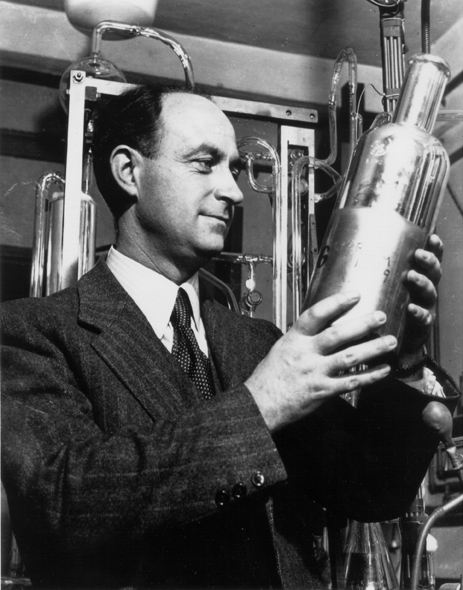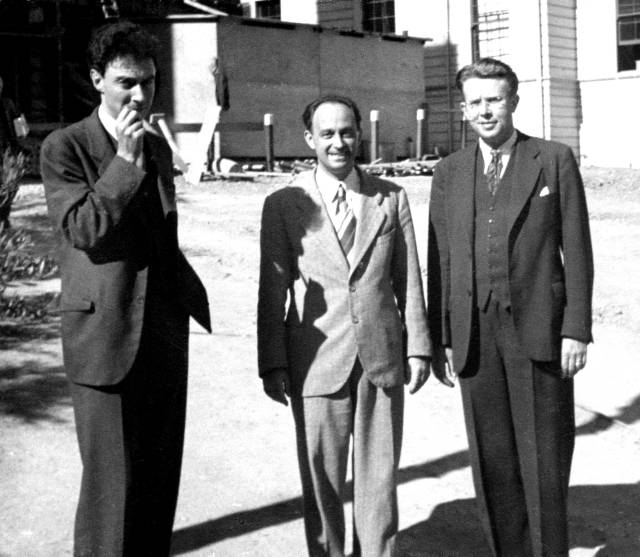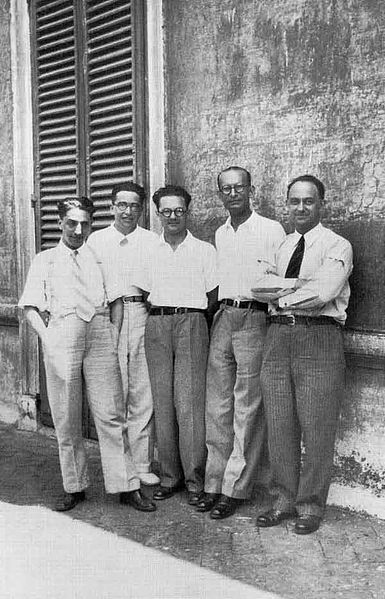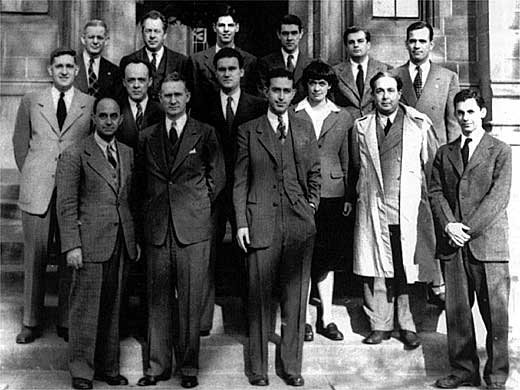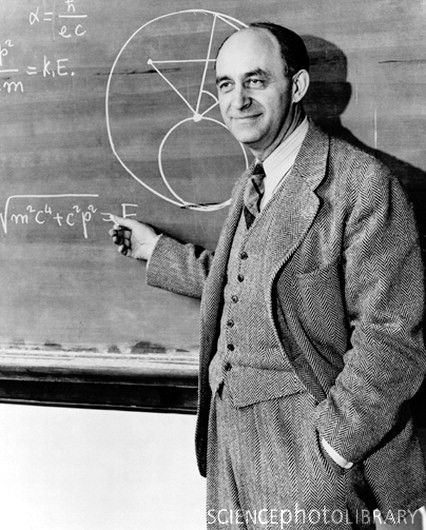<Back to Index>
- Physicist Enrico Fermi, 1901
PAGE SPONSOR
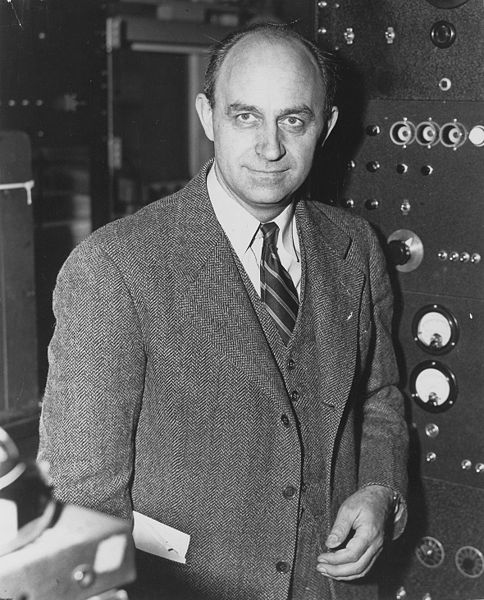
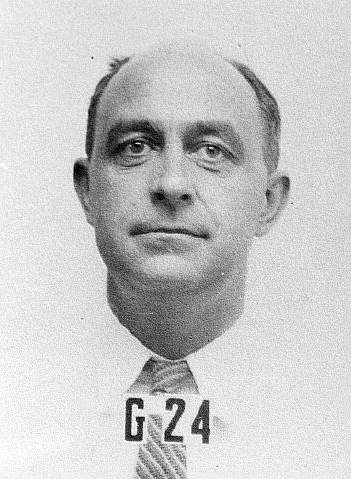
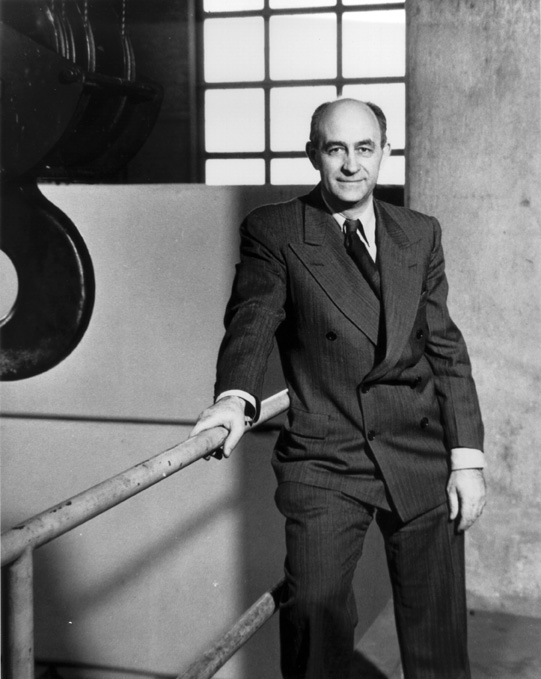
Enrico Fermi (29 September 1901 – 28 November 1954 was an an Italian born, naturalized American physicist particularly known for his work on the development of the first nuclear reactor, Chicago Pile-1, and for his contributions to the development of quantum theory, nuclear and particle physics, and statistical mechanics. He was awarded the 1938 Nobel Prize in Physics for his work on induced radioactivity.
Fermi is widely regarded as one of the leading scientists of the 20th century, highly accomplished in both theory and experiment. Along with J. Robert Oppenheimer, he is frequently referred to as "the father of the atomic bomb". He also held several patents related to the use of nuclear power.
Several awards, concepts, and institutions are named after Fermi, such as the Enrico Fermi Award, the Enrico Fermi Institute, the Fermi National Accelerator Lab, the Fermi Gamma ray Space Telescope, the Enrico Fermi Nuclear Generating Station, a type of particles called fermions, the synthetic element Fermium, and many more.
Enrico Fermi was born in Rome, Italy, to Alberto Fermi, a Chief Inspector of the Ministry of Communications, and Ida de Gattis, an elementary school teacher who built her own pressure cooker. As a young boy, he shared his interests with his older brother, Giulio. They dismantled small engines and other parts. When Giulio died unexpectedly of a throat abscess in 1915, Enrico was distraught, and immersed himself in scientific study to distract himself. According to his own account, each day he would walk in front of the hospital in which Giulio died until he became inured to the pain.
One of the first sources for the study of physics was a book found at the local market of Campo de' Fiori in Roma. The 900 page book, titled Elementorum physicae mathematicae, written in Latin by Jesuit Father Andrea Caraffa, a professor at the Collegio Romano, covered subjects like mathematics, classical mechanics, astronomy, optics, and acoustics.
Notes found in the book indicate that Fermi studied it intensely.
Later, Enrico befriended another scientifically inclined student named Enrico Persico, and the two worked together on scientific projects such as building gyroscopes, and measuring the Earth's magnetic field.
Fermi's interest in physics was further encouraged by Adolfo Amidei, a
friend of his father, who gave him several books on physics and
mathematics, which he read and assimilated quickly.
In 1918 Fermi enrolled at the Scuola Normale Superiore in Pisa, where he was later to receive his undergraduate and doctoral degree. In order to enter the Institute, candidates had to take an entrance exam which included an essay. For his essay on the given theme Characteristics of Sound, 17 year old Fermi chose to derive and solve the Fourier analysis based partial differential equation for waves on a string. The examiner, Prof. Giulio Pittato, interviewed Fermi and concluded that his essay would have been commendable even for a doctoral degree. Enrico Fermi achieved first place in the classification of the entrance exam. During his years at the Scuola Normale Superiore, Fermi teamed up with a fellow student named Franco Rasetti with whom he used to indulge in light hearted pranks. Later, Rasetti became Fermi's close friend and collaborator. Besides attending the classes, Enrico Fermi found the time to work on his extracurricular activities, particularly with the help of his friend Enrico Persico, who remained in Rome to attend the university. Between 1919 and 1923 Fermi studied general relativity, quantum mechanics and atomic physics.
His knowledge of quantum physics reached such a high level that the head of the Physics Institute, Prof. Luigi Puccianti, asked him to organize seminars about that topic. During this time he learned tensor calculus, a mathematical instrument invented by Gregorio Ricci and Tullio Levi - Civita, and needed to demonstrate the principles of general relativity. In 1921, his third year at the university, he published his first scientific works in the Italian journal Nuovo Cimento: the first was titled: On the dynamics of a solid system of electrical charges in transient conditions; the second: On the electrostatics of a uniform gravitational field of electromagnetic charges and on the weight of electromagnetic charges. At first glance, the first paper seemed to point out a contradiction between the electrodynamic theory and the relativistic one concerning the calculation of the electromagnetic masses. After one year with a work entitled Correction of severe discrepancy between electrodynamic theory and the relativistic one of electromagnetic charges. Inertia and weight of electricity, Enrico Fermi showed the correctness of his paper. This last publication was so successful that it was translated into German and published in the famous German scientific journal Physikalische Zeitschrift.
In 1922 he published his first important scientific work in the Italian journal I Rendiconti dell'Accademia dei Lincei entitled "On the phenomena that happen close to the line of time", where he introduces for the first time the so-called "Fermi coordinates", and proves that when close to the time line, space behaves as a euclidean one. In 1922 Fermi graduated from Scuola Normale Superiore.
In 1923, while writing the appendix for the Italian edition of the book The Mathematical Theory of Relativity by A. Kopff, Enrico Fermi pointed out, for the first time, that hidden inside the famous Einstein equation (E = mc2), there was an enormous amount of nuclear potential energy to be exploited.
Fermi's Ph.D advisor was Luigi Puccianti. In 1924 Fermi spent a semester at the University of Göttingen, and then stayed for a few months in Leiden with Paul Ehrenfest. From January 1925 to the autumn of 1926, he stayed at the University of Florence. In this period he wrote his work on the Fermi – Dirac statistics.
Aged 24, Fermi took a professorship at the University of Rome (first in atomic physics in Italy) which he won in a competition held by Professor Orso Mario Corbino, director of the Institute of Physics. Corbino helped Fermi in selecting his team, which soon was joined by notable minds like Edoardo Amaldi, Bruno Pontecorvo, Franco Rasetti and Emilio Segrè. For the theoretical studies only, Ettore Majorana also took part in what was soon nicknamed "the Via Panisperna boys"
(after the name of the road in which the Institute had its labs). The
group went on with its now famous experiments, but in 1933 Rasetti left
Italy for Canada and the United States, Pontecorvo went to France and
Segrè left to teach in Palermo.
During their time in Rome, Fermi and his group made important contributions to many practical and theoretical aspects of physics. These include the theory of beta decay, later referred to as the theory of the "weak interaction" (one of the 4 basic forces in nature, then brand new) with the inclusion of the neutrino postulated in 1930 by Wolfgang Pauli, and the discovery of slow neutrons, which was to prove pivotal for the working of nuclear reactors. His group systematically bombarded elements with slow neutrons, and during their experiments with uranium, narrowly missed observing nuclear fission. At that time, fission was thought to be improbable if not impossible, mostly on theoretical grounds. While people expected elements with higher atomic number to form from neutron bombardment of lighter elements, nobody expected neutrons to have enough energy to actually split a heavier atom into two light element fragments. However, the chemist Ida Noddack had criticised Fermi's work and had suggested that some of his experiments could have produced lighter elements. At the time, Fermi dismissed this possibility on the basis of calculations.
Fermi was well known for his simplicity in solving problems. He began his inquiries with the simplest lines of mathematical reasoning, then later produced complete solutions to the problems he deemed worth pursuing. His abilities as a great scientist, combining theoretical and applied nuclear physics, were acknowledged by all. He influenced many physicists who worked with him, such as Hans Bethe, who spent two semesters working with Fermi in the early 1930s. From the time he was a boy, Fermi meticulously recorded his calculations in notebooks, and later used them to solve many new problems that he encountered based on these earlier known problems.
When Fermi submitted his paper on beta decay to the prestigious journal Nature, the journal's editor turned it down because "it contained speculations which were too remote from reality". Thus Fermi saw the theory published in Italian and in German before it was published in English. Nature eventually did publish Fermi's report on beta decay on January 16, 1939.
Fermi remained in Rome until 1938.
In 1938, Fermi received the Nobel Prize in Physics at the age of 37 for his "demonstrations of the existence of new radioactive elements produced by neutron irradiation, and for his related discovery of nuclear reactions brought about by slow neutrons". After Fermi received the Nobel Prize in Stockholm, he, his wife Laura, and their children emigrated to New York. This was mainly because of the Manifesto of Race promulgated by the fascist regime of Benito Mussolini in order to bring Italian Fascism ideologically closer to German Nazism. The new laws threatened Laura, who was Jewish. Also, the new laws put most of Fermi's research assistants out of work. Soon after his arrival in New York, Fermi began working at Columbia University.
In December 1938, the German chemists Otto Hahn and Fritz Strassmann sent a manuscript to Naturwissenschaften reporting they had detected the element barium after bombarding uranium with neutrons; simultaneously, they communicated these results to Lise Meitner. Meitner, and her nephew Otto Robert Frisch, correctly interpreted these results as being nuclear fission. Following an advice of George Placzek, Frisch confirmed this experimentally on 13 January 1939.
Meitner's and Frisch's interpretation of the work of Hahn and Strassmann crossed the Atlantic Ocean with Niels Bohr, who was to lecture at Princeton University. Isidor Isaac Rabi and Willis Lamb, two Columbia University physicists working at Princeton, heard the news and carried it back to Columbia. Rabi said he told Enrico Fermi; Fermi gave credit to Lamb. Bohr soon thereafter went from Princeton to Columbia to see Fermi. Not finding Fermi in his office, Bohr went down to the cyclotron area and found Herbert L. Anderson. Bohr grabbed him by the shoulder and said: “Young man, let me explain to you about something new and exciting in physics.” It was clear to a number of scientists at Columbia that they should try to detect the energy released in the nuclear fission of uranium from neutron bombardment. On 25 January 1939, a Columbia University team conducted the first nuclear fission experiment in the United States, which was done in the basement of Pupin Hall; the members of the team were Herbert L. Anderson, Eugene T. Booth, John R. Dunning, Enrico Fermi, G. Norris Glasoe, and Francis G. Slack. The next day, the Fifth Washington Conference on Theoretical Physics began in Washington, D.C. under the joint auspices of The George Washington University and the Carnegie Institution of Washington. There, the news on nuclear fission was spread even further, which fostered many more experimental demonstrations.
While at Columbia during World War II, Fermi and his wife resided in Leonia, New Jersey.
Fermi then went to the University of Chicago and began studies that led to the construction of the first nuclear pile Chicago Pile-1. Fermi recalled the beginning of the project in a speech given in 1954 when he retired as President of the American Physical Society:
- "I remember very vividly the first month, January, 1939, that I started working at the Pupin Laboratories because things began happening very fast. In that period, Niels Bohr was on a lecture engagement at the Princeton University and I remember one afternoon Willis Lamb came back very excited and said that Bohr had leaked out great news. The great news that had leaked out was the discovery of fission and at least the outline of its interpretation. Then, somewhat later that same month, there was a meeting in Washington where the possible importance of the newly discovered phenomenon of fission was first discussed in semi - jocular earnest as a possible source of nuclear power."
In August 1939 Leó Szilárd prepared and Albert Einstein signed the famous letter warning President Franklin D. Roosevelt of the probability that the Nazis were planning to build an atomic bomb. Because of Hitler's September 1 invasion of Poland, it was October before they could arrange for the letter to be personally delivered. Roosevelt was concerned enough that the Uranium Committee was assembled, and awarded Columbia University the first nuclear power funding of US$ 6,000. However, due to bureaucratic fears of foreigners doing secret research, the money was not actually issued until Szilárd implored Einstein to send a second letter to the president in the spring of 1940. The money was used in studies which led to the first nuclear reactor — Chicago Pile-1, a massive "atomic pile" of graphite bricks and uranium fuel which went critical on December 2, 1942, built in a hard racquets court under Stagg Field, the football stadium at the University of Chicago. Due to a mistranslation, Soviet reports on Enrico Fermi claimed that his work was performed in a converted "pumpkin field" instead of a "squash court", squash being an offshoot of hard racquet. This experiment was a landmark in the quest for energy, and it was typical of Fermi's brilliance. Every step had been carefully planned, every calculation meticulously done by him. When the first self sustained nuclear chain reaction was achieved, a coded phone call was made by one of the physicists, Arthur Compton, to James Conant, chairman of the National Defense Research Committee. The conversation was in impromptu code:
- Compton: The Italian navigator has landed in the New World.
- Conant: How were the natives?
- Compton: Very friendly.
This successful initiation of a chain reacting pile was important not only for its help in assessing the properties of fission — needed for understanding the internal workings of an atomic bomb — but also because it would serve as a pilot plant for the massive reactors which would be created in Hanford, Washington, which would then be used to produce the plutonium needed for the bombs used at the Trinity site and Nagasaki. Eventually Fermi and Szilárd's reactor work was folded into the Manhattan Project.
Fermi moved to Los Alamos National Laboratory in the later stages of the Manhattan Project to serve as a general consultant. He was sitting in the control room of the Hanford B Reactor when it first went critical in 1944. His broad knowledge of many fields of physics was useful in solving problems that were of an interdisciplinary nature. He became a naturalized citizen of the United States of America in 1944.
Fermi was present as an observer of the Trinity test on July 16, 1945. Engineer Jack Aeby saw Fermi at work:
As the shock wave hit Base Camp, Aeby saw Enrico Fermi with a handful of torn paper. "He was dribbling it in the air. When the shock wave came it moved the confetti. He thought for a moment."Fermi had just estimated the yield of the first nuclear explosion. It was in the ball park.
Fermi's strips - of - paper estimate was ten kilotons of TNT; the actual yield was about 19 kilotons.
In 1947, Fermi invented the FERMIAC, an analog computer that used the Monte Carlo Method to study neutron transport through fissionable materials.
In Fermi's 1954 address to the American Physical Society (APS) he also said, "Well, this brings us to Pearl Harbor. That is the time when I left Columbia University, and after a few months of commuting between Chicago and New York, eventually moved to Chicago to keep up the work there, and from then on, with a few notable exceptions, the work at Columbia was concentrated on the isotope separation phase of the atomic energy project, initiated by Booth, Dunning and Urey about 1940".
Fermi was widely regarded as the only physicist of the twentieth century who excelled both theoretically and experimentally. The well known historian of physics, C.P. Snow, says about him, "If Fermi had been born a few years earlier, one could well imagine him discovering Rutherford's atomic nucleus, and then developing Bohr's theory of the hydrogen atom. If this sounds like hyperbole, anything about Fermi is likely to sound like hyperbole". Fermi's ability and success stemmed as much from his appraisal of the art of the possible, as from his innate skill and intelligence. He disliked complicated theories, and while he had great mathematical ability, he would never use it when the job could be done much more simply. He was famous for getting quick and accurate answers to problems which would stump other people. Later on, his method of getting approximate and quick answers through back - of - the - envelope calculations became informally known as the 'Fermi method'.
Fermi's most disarming trait was his great modesty, and his ability to do any kind of work, whether creative or routine. It was this quality that made him popular and liked among people of all strata, from other Nobel Laureates to technicians. Henry DeWolf Smyth, who was Chairman of the Princeton Physics department, had once invited Fermi over to do some experiments with the Princeton cyclotron. Walking into the lab one day, Smyth saw the distinguished scientist helping a graduate student move a table, under another student's directions. Another time, a Du Pont executive made a visit to see him at Columbia. Not finding him either in his lab or his office, the executive was surprised to find the Nobel Laureate in the machine shop, cutting sheets of tin with a big pair of shears.
After the war, Fermi served for a short time on the General Advisory Committee of the Atomic Energy Commission, a scientific committee chaired by J. Robert Oppenheimer which advised the commission on nuclear matters and policy. After the detonation of the first Soviet fission bomb in August 1949, he, along with Isidor Rabi, wrote a strongly worded report for the committee which opposed the development of a hydrogen bomb on moral and technical grounds. But Fermi also participated in preliminary work on the hydrogen bomb at Los Alamos as a consultant, and along with Stanislaw Ulam, calculated that the amount of tritium needed for Edward Teller's model of a thermonuclear weapon would be prohibitive, and a fusion reaction could not be assured to propagate even with this large quantity of tritium.
Fermi was among the scientists who testified on Oppenheimer's behalf at an AEC hearing in 1954. The hearing resulted in denial of Oppenheimer's security clearance.
In his later years, Fermi did important work in particle physics, especially related to pions and muons. He was also known to be an inspiring teacher at the University of Chicago, and was known for his attention to detail, simplicity, and careful preparation for a lecture. Later, his lecture notes, especially those for quantum mechanics, nuclear physics, and thermodynamics, were transcribed into books which are still in print.
He also mused about a proposition which is now referred to as the "Fermi Paradox". This contradiction or proposition is this: that with the billions and billions of star systems in the universe, one would think that intelligent life would have contacted our civilization by now.
Toward the end of his life, Fermi questioned his faith in society at large to make wise choices about nuclear technology. He said:
- "Some of you may ask, what is the good of working so hard merely to collect a few facts which will bring no pleasure except to a few long - haired professors who love to collect such things and will be of no use to anybody because only few specialists at best will be able to understand them? In answer to such question[s] I may venture a fairly safe prediction.
- History of science and technology has consistently taught us that scientific advances in basic understanding have sooner or later led to technical and industrial applications that have revolutionized our way of life. It seems to me improbable that this effort to get at the structure of matter should be an exception to this rule. What is less certain, and what we all fervently hope, is that man will soon grow sufficiently adult to make good use of the powers that he acquires over nature."
Fermi died at age 53 of stomach cancer (a result of heavy exposure to radiation in Chicago, Illinois, and was interred at Oak Woods Cemetery. Two of his graduate students who assisted him in working on or near the nuclear pile also died of cancer. Fermi and his team knew that such work carried considerable risk but they considered the outcome so vital that they forged ahead with little regard for their own personal safety.
As Eugene Wigner wrote:
"Ten days before Fermi had died he told me, 'I hope it won't take
long.' He had reconciled himself perfectly to his fate".
Enrico Fermi had been the first to use a neutron to produce the radioactive change of one element to another. On 2 December 1942 he initiated the atomic age with the first self sustaining chain reaction, after which he became known as "father of the atomic bomb". Michael H. Hart ranked him #76 in his list of the most influential figures in history.
- The Fermilab particle accelerator and physics lab in Batavia, Illinois, is named after him.
- Three nuclear reactor installations have been named after Fermi:
- Fermi 1 and Fermi 2 nuclear power plants in Newport, Michigan;
- Enrico Fermi Nuclear Power Plant, in Italy;
- RA-1 Enrico Fermi, a research reactor in Argentina.
- Many schools are also named after him, such as the Enrico Fermi High School in Enfield, Connecticut.
- Particles with half-valued spins are called fermions, as they obey the Fermi – Dirac statistics.
- Fermi Court in Deep River, Ontario, is named in his honor.
- In 1952, element 100 on the periodic table of elements was isolated from the debris of a nuclear test. In honor of Fermi's contributions to the scientific community, it was named fermium.
- Since the 1950s, the United States Atomic Energy Commission has named its highest honor, the Fermi Award, after him. Recipients of the award include well known scientists like Otto Hahn, J. Robert Oppenheimer, Freeman Dyson, John Wheeler and Hans Bethe.
- In 1976, he was inducted into the National Inventors Hall of Fame.
- In 2008, the newly launched Fermi Gamma - ray Space Telescope was named after him.
